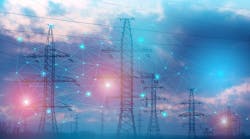With the new year in sight, the energy industry will undergo several changes in the coming months. The aging power grid is being put to the test, as it stretches to support a much higher volume of users than it was designed for in far more strenuous circumstances. There’s a clear need for a more resilient power grid, with climate change experts indicating that global warming will cause an uptick in natural disasters in the coming years. On top of that, the call for carbon neutrality and net-zero emissions has bolstered efforts to transition toward green energy, and as new regulations trickle out, the industry will need to adjust to changes in standards that could dramatically alter operations.
However, hope is on the horizon as new artificial intelligence (AI) technologies are forging the way toward a data-focused energy industry, one able to predict and prevent power grid issues in the future. There are several ways that utilities can adapt and change their operations and infrastructure to not only be greener, but more efficient than ever before. The planning capabilities that AI offers the energy sector will combat some of the industry’s most pressing challenges.
1. Boost the power grid with artificial intelligence.
One way that AI will make waves in the energy industry is by solving aging power grid inefficiencies. It’s no secret that the current construction and design of the nation's power infrastructure is far from efficient. Even though day-to-day life has typically only been hindered when faced with extreme weather conditions, the grid's lack of resilience will become more apparent with increases in climate-change-related events and more devices connecting to the grid.
While innovations like battery storage and microgrids are good opportunities to improve the power supply, they still require immense amounts of computing power to optimize how the power is integrated on the network — AI technologies will soon serve as a solution to this.
As an example, AI can analyze the droves of data being produced by factories and other energy consumers to accurately predict when there will be an abundance of energy supply to charge batteries versus when to drain them based on multiple factors including availability, cost, reserves, and redundancy. While this binary decision of how to run the batteries at a certain time might seem simple, it becomes much more complex when it’s applied to forecasting operations over a time horizon. Artificially intelligent time horizon analyses and predictions will lead to dramatic improvements, allowing utilities and grid operators to see the full picture of their operations for now and the future. AI will play a pivotal role in energy transformation as it is the only technology that can sift through all data points, including past weather conditions, the network's current state, the forecast load demands, and potential fault points.
2. Plan for efficient operations.
Specifically, AI technologies can help predict energy consumption levels for days in advance, allowing producers to plan their operations for the anticipated demands and precisely generate energy. This will help energy producers prepare for production shortfalls and reconcile any kind of a reserve power in case of unexpected events, such as a sudden weather change or other issues within the power grid.
This process of planning to support demand forecasts is a constant exercise for all the Independent System Operators (ISO) responsible for the operation of the U.S. power grid. These factors, and many more, are crucial to know when to store energy or possibly cut off into microgrids to achieve a constant energy flow and meet consumption demand. This not only saves energy, but also relieves stress by putting restrictions and limitations on the grid that take line capacity and congestion into consideration.
3. Pave the way for renewable energy.
Another way AI solutions will play a key role in the energy industry’s transformation is through the integration of renewable energy sources, like solar and wind, into the power grid. By anticipating weather conditions using historical data and impending weather patterns, these solutions can predict the availability of naturall generated energy. This provides managers with the ability to forecast the mix of renewable energy and traditional fossil fuel energy that is required to satisfy the anticipated demand while maximizing the use of renewable energy. By necessity, such a forecasting solution must take into consideration operational constraints when changing equipment set points throughout the day from ambient condition and load demand changes. With an increasing amount of renewable energy coming online, AI solutions will soon handle the complexity of the entire system. This also makes renewable energy sources more appealing in the energy sector, as a previously unpredictable source of power will become increasingly reliable. In helping the industry transition to renewable energy sources, AI solutions will light the way to a safer, greener future.
Stephen Kwan is director of Product Management at Beyond Limits.


